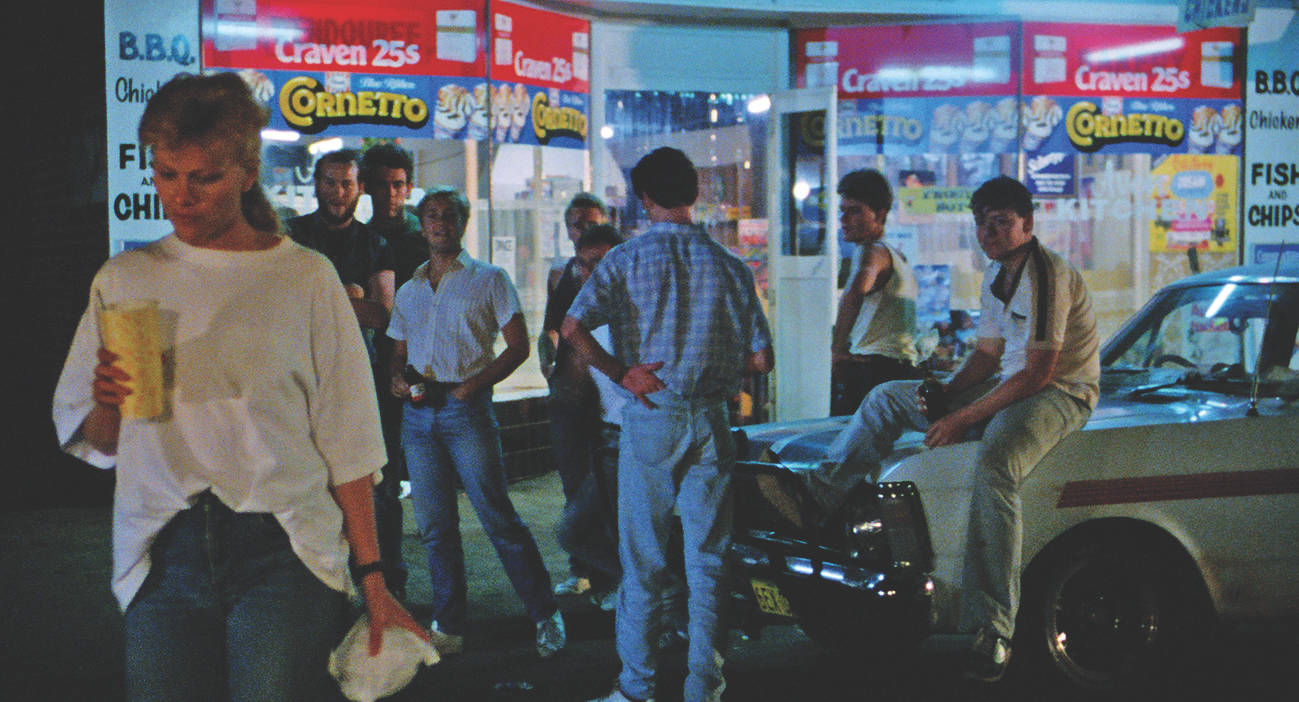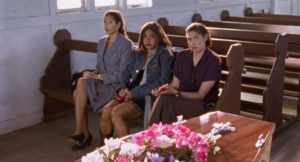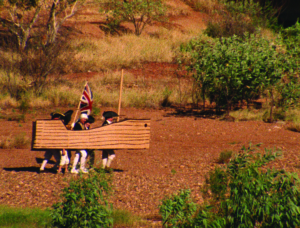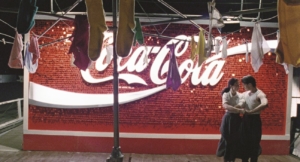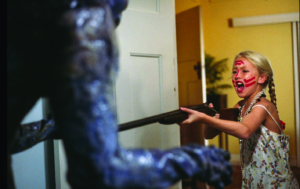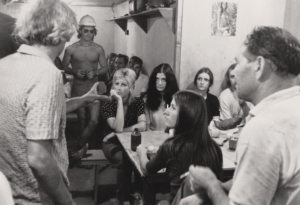There’s an entire generation of us who grew up with Steve Jodrell’s Shame (1988). Whether we watched it at school to discuss ‘social issues’ like class and sexism, or just saw it on TV at home, sitting awkwardly next to our parents on the sofa, Shame was, for many of us, the first time a movie showed us the grim reality of what gender difference could mean when it came to power relations in a very real, very familiar Australian context.
This wasn’t the distant nightmare scenario experienced by Jodie Foster’s Sarah Tobias in The Accused (Jonathan Kaplan, 1988) or the faraway feminist fantasy of Geena Davis’ and Susan Sarandon’s titular characters in Thelma & Louise (Ridley Scott, 1991); the women in Shame had the same accents we did, the same clothes, and had the same groceries and magazines in their houses. Many of them we knew from locally produced kids television shows and sitcoms that we watched, zonked out after school. We’d grown up with a lot of these people. They felt like family.
On this front, revisiting Shame now – at a cultural moment when critical and mainstream discourse surrounding sexual violence and harassment have been transformed by the #MeToo movement[1]See Nadia Khomami, ‘#MeToo: How a Hashtag Became a Rallying Cry Against Sexual Harassment’, The Guardian, 21 October 2017, <https://www.theguardian.com/world/2017/oct/20/women-worldwide-use-hashtag-metoo-against-sexual-harassment>, accessed 16 November 2018. – is a shattering experience when considering the centrality of actor Simone Buchanan and her close association with one of the most shocking child-sexual-abuse scandals in Australian screen-industry history. In Shame, Buchanan plays Lizzie Curtis, a teenager who is gang-raped in the fictional country town of Ginborak. When big-city lawyer Asta Cadell (Deborra-lee Furness) comes to town, Lizzie’s experience reveals the ugliness and viciousness that has long bubbled underneath the flimsy veneer of civility not only in this tiny make-believe town, but across Australian society more broadly.
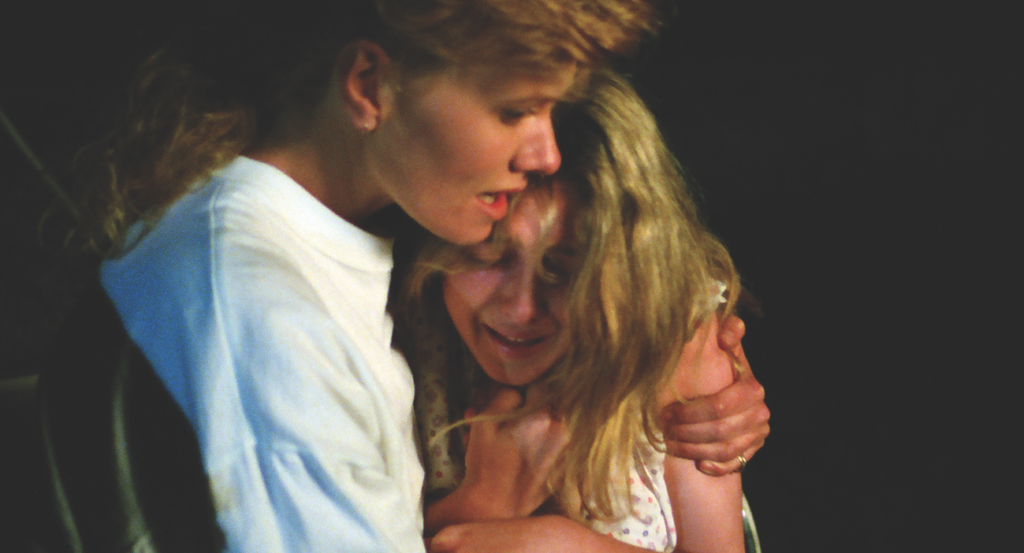
Buchanan was undoubtedly one of Australia’s most beloved teen actors of the 1980s, largely due to her three-year stint on popular Australian sitcom Hey Dad..!, in which she starred as young Debbie Kelly. In 2014, Robert Hughes – the actor who played Debbie’s father, the iconic and widely loved Martin, who is raising his children alone after the death of his wife – was found guilty of ten separate charges of sexual and indecent assault against four women, who were all young girls at the time; his criminal offences spanned a period of twenty years, including the peak of his Hey Dad..! success. But it was not only the testimony of these four women that saw a man once considered one of the most powerful figures in Australian television imprisoned – a number of other witnesses (including his family members) also provided ‘tendency evidence’ that supported the prosecution’s case that Hughes was a long-term sexual predator against children.[2]‘Robert Hughes Sentenced for Child Sex Offences’, SBS News, 16 May 2014, <https://www.sbs.com.au/news/robert-hughes-sentenced-for-child-sex-offences>, accessed 1 November 2018.
To the public, at least, the first revelations about Hughes’ criminal behaviour emerged in the form of allegations made by actor Sarah Monahan – who played Martin’s daughter and Debbie’s younger sister, Jenny – to Woman’s Day magazine in early 2010.[3]‘Hey Dad! Star Claims “I Was Abused on Set”’, News.com.au, 18 March 2010, <https://www.news.com.au/entertainment/tv/hey-dad-star-sarah-monahan-claims-i-was-abused-on-set/news-story/244408691e6e7f4f8fa3dafc7601db86>, accessed 16 November 2018. Buchanan immediately came out in support of Monahan, publicly adding not only that she knew about the ongoing abuse against her co-star, but also that Hey Dad..! executive producer Gary Reilly had become ‘very, very angry’ with her public corroboration of Hughes’ inappropriate behaviour: ‘He said: “If I hear you speaking about this again anywhere, I’ll see to it you’ll never work in this country again”.’[4]Simone Buchanan, quoted in ‘Hey Dad! Co-star “Threatened” over Sex Abuse Claims’, The Age, 26 March 2010, <https://www.theage.com.au/national/hey-dad-costar-threatened-over-sex-abuse-claims-20100326-r0bw.html>, accessed 16 November 2018.
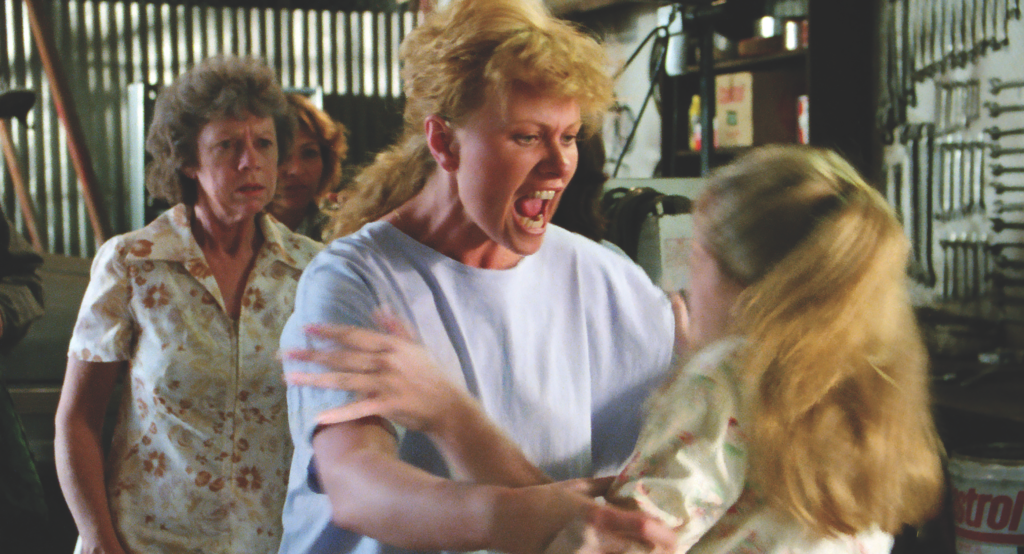
In a world in which the way we speak about sexual violence, power and the workplace has been fundamentally changed by the #MeToo movement, which exploded in late 2017 after a seemingly endless list of allegations against once-invincible Hollywood heavyweight producer Harvey Weinstein was publicised in The New York Times and The New Yorker,[5]See Jodi Kantor & Megan Twohey, ‘Harvey Weinstein Paid Off Sexual Harassment Accusers for Decades’, The New York Times, 5 October 2017, <https://www.nytimes.com/2017/10/05/us/harvey-weinstein-harassment-allegations.html>; and Ronan Farrow, ‘From Aggressive Overtures to Sexual Assault: Harvey Weinstein’s Accusers Tell Their Stories’, The New Yorker, 23 October 2017, <https://www.newyorker.com/news/news-desk/from-aggressive-overtures-to-sexual-assault-harvey-weinsteins-accusers-tell-their-stories>, both accessed 15 November 2018. Monahan and Buchanan’s experiences on Hey Dad..! sound distressingly familiar. But – to state the obvious – Monahan, with Buchanan’s support, went public about her horrific experiences almost eight years before the original ‘Me Too’ movement (founded by Tarana Burke in 2006) rose to widespread attention with the 2017 Weinstein allegations; there was no mass movement through which she could grow her own courage to speak up against the violence that happened to her as a child. It’s not easy for any victim of sexual assault to speak up – regardless of their gender – but #MeToo has, at least in part, been a widespread attempt to make the task less isolating. It is in this light, within the context of the Australian contingent of the movement spearheaded by journalist Tracey Spicer,[6]See Lisa Murray, ‘Tracey Spicer: More to Come from #MeToo’, Australian Financial Review, 16 February 2018, <https://www.afr.com/lifestyle/arts-and-entertainment/tracey-spicer-more-to-come-from-metoo-20180215-h0w4sn>, accessed 16 November 2018. that Monahan is nothing short of a groundbreaker, a pioneer of extraordinary strength and unambiguous courage.
With Buchanan’s relationship to the Hey Dad..! case providing a kind of ethical scaffolding, watching Shame now becomes a more shocking, urgent experience, simply by virtue of the continued relevance of the story it tells about gender, power and sexual violence.
With Buchanan’s relationship to the Hey Dad..! case providing a kind of ethical scaffolding, watching Shame now becomes a more shocking, urgent experience, simply by virtue of the continued relevance of the story it tells about gender, power and sexual violence. Nothing, it seems, has changed. Every shot of Buchanan reminds us of this: whereas once we might have reflected casually on how Shame’s Lizzie and Debbie differ, today, it is virtually impossible to not think about the very real horrors her co-star Monahan was experiencing on set, along with Buchanan’s own career being threatened when she attempted to speak up.
This article looks back on Shame, but finds the film looking directly – and with almost-surgical precision – towards this moment, three decades from when it was first released. We watch Shame in 2019 and are forced to address not only abuses that have happened in the past, but also those that are still occurring, both in Australia and abroad.
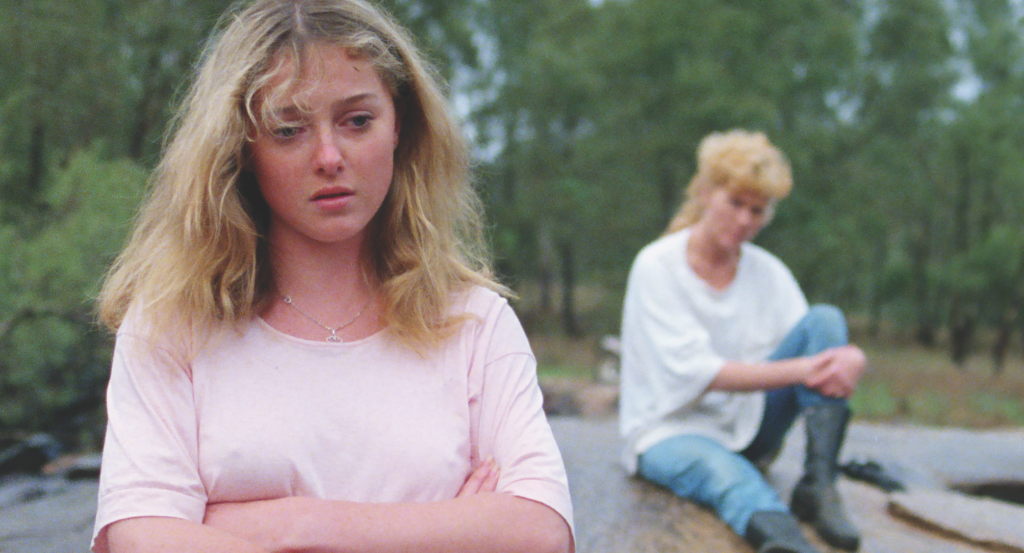
Welcome to Ginborak
Shame begins as Asta – a leather-wearing barrister from the city – rides her motorcycle into Ginborak and encounters difficulties with her engine. Finding herself stuck in the middle of nowhere as she waits for a mechanic to deliver a necessary part so her bike can be fixed, she meets the members of the Curtis family, particularly troubled fifteen-year-old Lizzie. Asta learns that she was raped by a gang led by Danny Fiske (David Franklin), the spoilt son of Ginborak’s wealthy, powerful matriarch Mrs Rudolph (Pat Skevington), who owns the meatworks that forms the central industry that supports the town. Danny and his friends terrorise not only Lizzie but the town’s women in general – behaviour that is rather explicitly justified by Mrs Rudolph and even the police as a manifestation of the Australian ‘wild colonial boys’ mythology: boys, we’re told once again, will be boys.
Outraged by the injustice and mistreatment of Lizzie, who is rendered a social pariah and treated as if she were the criminal, Asta uses her legal experience and sophistication as an urban outsider to rally the frightened women of the town to stand with the Curtis family, granting Lizzie the strength to press charges. Released on bail, the angry gang ransack the Curtis home, kidnap Lizzie’s grandmother, Norma (Margaret Ford), and brutally beat her father, Tim (Tony Barry).
Naively believing the local police station to be a safe refuge for Lizzie, Asta takes the girl there. But, while the police and the town’s angry women are rescuing Norma after her abductors attempt to sexually assault her, they realise Lizzie is alone in the police station and easily accessible to the gang, who then proceed to kidnap her. As she and the boys speed away, Lizzie falls out of the moving vehicle and dies on impact with the road. Desperate to find Lizzie, Asta is pushed to the edge and assaults one of the boys who cruelly feigns ignorance as to Lizzie’s whereabouts. When the girl’s lifeless body is found, it is not the boys but Asta herself whom the police hold responsible: ‘I hope you’re bloody satisfied,’ she is told. Before she can reply, however, a local woman speaks up in her place with clear, furious determination: ‘No, we’re not satisfied, not by a long way.’ The film’s final image shows Asta’s expression of shock, resignation and failure.
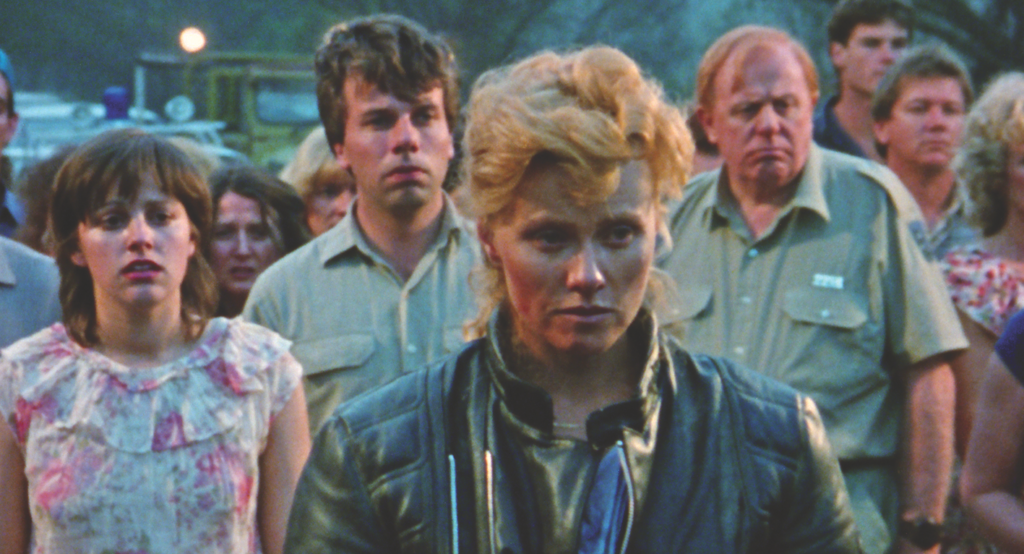
Shot on 16mm in the small town of Toodyay, around 70 kilometres north-east of Perth, Shame was, by his own admission, a good fit for director Jodrell’s personal politics: ‘I’m very, very anti-institution. I’m against any institutionalised activity which tends to diminish personal responsibility – anything at all that favours a group ethic’.[7]Steve Jodrell, quoted in Bron Sibree, ‘Steve Jodrell After Shame’, Cinema Papers, issue 70, November 1988, p. 32. In another interview conducted while the film was still in post-production, he revealed that the film was roughly based on a true story of events from the late 1970s in a sugarcane-farming town in northern Queensland: ‘The boys would go out during the weekend and systematically rape the women of the town,’ Jodrell told The West Australian.
Shame was one of the best-written scripts that I had ever had the privilege of reading […] Everyone liked it, but they didn’t know what to do with a film about rape and repression […] They would say ‘who wants to go and see women suffering – people want escapism’.[8]Steve Jodrell, quoted in Julie Waters, ‘A (Male) Director’s Reflections on a Film About Rape’, The West Australian, 5 June 1986, p. 56.
Despite the film’s initial difficulties securing funding,[9]See Wendy Caccetta, ‘Proud About Shame’, Daily News (Perth), 26 February 1988, p. 55. critics in Australia and the US were broadly vocal in their praise for it. Dougal Macdonald at The Canberra Times declared that ‘Shame is by any measure a first-class, strong Australian drama worthy of being seen in this country and overseas.’[10]Dougal Macdonald, ‘First-class Drama with Horror but Not Fantasy’, The Canberra Times, 10 June 1988, p. 38. Caryn James at The New York Times virtually bubbled with excitement and praise:
It is easy to find soft-headed movies that pretend to be about women’s roles in society, and much harder to come across a film as good as Shame, a tough-minded Australian action story with a smart, sensitive, unsettling macho heroine.[11]Caryn James, ‘A Macho Australian Arrives on Her Cycle’, The New York Times, 19 March 1988, <https://www.nytimes.com/1988/03/19/movies/review-film-a-macho-australian-arrives-on-her-cycle.html>, accessed 16 November 2018.
Sandra Hall at The Bulletin shared this sentiment, celebrating the film with the eloquent observation that it ‘comes on like a Rambo for feminists’.[12]Sandra Hall, ‘The Feminist Superwoman’, The Bulletin, 10 May 1988, p. 112. The film’s gender politics would permeate other critical assessments of the film, with David Stratton noting, for instance, that Shame ‘exposes, like no feature film since Wake in Fright, the dark side of Australian mateship’.[13]David Stratton, The Avocado Plantation: Boom and Bust in the Australian Film Industry, Pan Macmillan, Sydney, 1990, p. 219. This reference to Ted Kotcheff’s iconic 1971 Australian psychological-horror film also significantly flags the centrality of genre – particularly western and rape-revenge – to Shame, a factor that allowed Jodrell to propel the story’s ideological core so effectively.
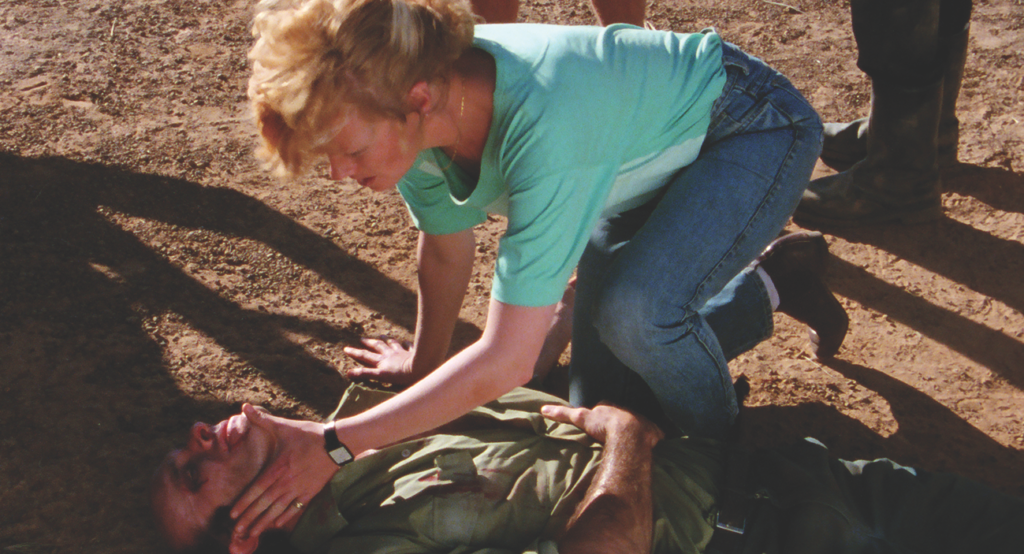
From western to rape-revenge to tragedy
Numerous critics drew parallels between Shame and the western, particularly George Stevens’ Shane (1953), which Jodrell’s film evokes simply through its similar-sounding title.[14]See Stuart Cunningham, Framing Culture: Criticism and Policy in Australia, Allen & Unwin, Sydney, 1992, p. 149; Rose Lucas, ‘Shame’, in Scott Murray (ed.), Australian Film: 1978–1992, Oxford University Press, Melbourne, 1993, p. 257; and Evan Williams, ‘The Lone Rider Routs the Lotus’, The Weekend Australian, 30 April – 1 May 1988, p. 63. But, while the western was certainly a strong generic influence on Shame, it was by no means the only one; as Jodrell noted at the time, ‘I liked the western elements, the social commitment and the fact that this important message was contained within the formula of a drive-in style movie.’ Although somewhat vague, this gesture towards the ‘drive-in style movie’[15]Steve Jodrell, quoted in Stratton, op. cit., p. 219. is a significant acknowledgement of the additional influence of the lowbrow and broadly disdained rape-revenge genre, a staple of exploitation cinema despite its origins in such highbrow fare as Ingmar Bergman’s Oscar-winning The Virgin Spring (1960). At the time of Shame’s American release, this highbrow–lowbrow tension was tackled head-on by cult drive-in film-criticism legend Joe Bob Briggs, who very comfortably placed Jodrell’s film squarely in the rape-revenge category, although not using those words explicitly:
Shame is a new flick about a motorcyclist who rides into town, finds out some creepolas are raping the high school girls and starts kicking hiney. Usually, you put this Charles Bronson plot on the big screen, and [Roger] Ebert and [Gene] Siskel can’t wait to get their claws in it. Writers for the New York Slimes stand in line to call it the most disgusting movie in history. This one, though, gets shown at film festivals and always gets great reviews. What’s the reason? They made it over in Australia, and the motorcyclist Bronson-type is a woman. Yeah. Right. Fortunately, I have no male–female prejudice and so I recognize a great revenge movie no matter who’s bashing heads.
Briggs ultimately gave it the thumbs-up via his signature list-count mode of judgement: ‘No breasts (feminism). Some 174 construction-worker remarks, some of ’em fairly funny. Twenty uses of the word “slut”. Four Stars. Joe Bob says check it out.’[16]Joe Bob Briggs, ‘Vengeful Woman Cuts Rapists Down to Size’, The San Francisco Examiner, 19 February 1989, p. 25.
While critical discussion about Shame has privileged the important influence of the western, predominantly at the expense of the lowlier rape-revenge film, I argue strongly that, in fact, the two overlap and intersect, as they have done historically. The moral expectations that accompany rape-revenge are deliberately and meaningfully subverted in Shame precisely because of how the rape-revenge tradition has historically been intertwined with the western.
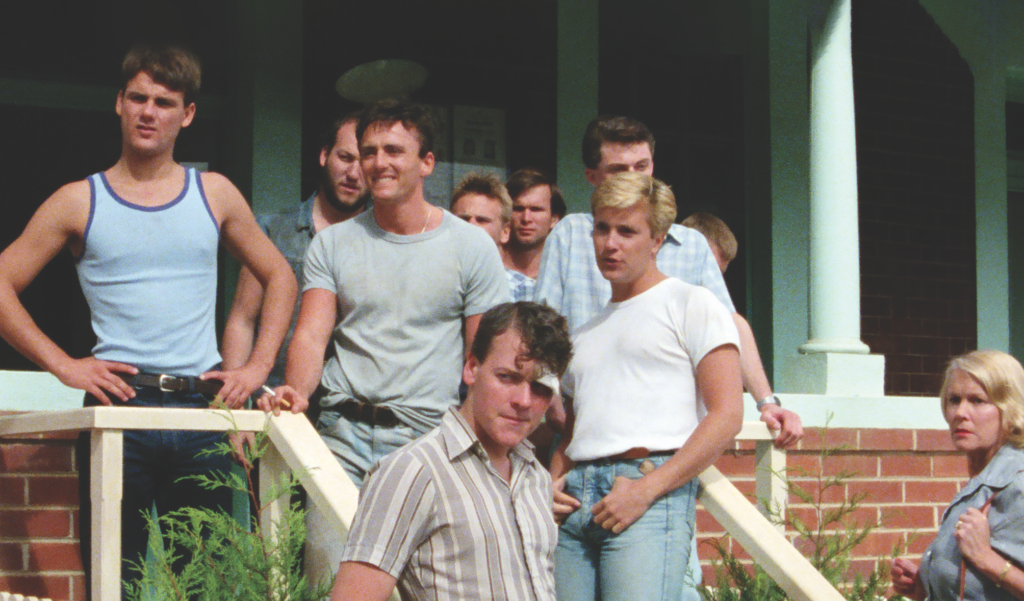
As Jacinda Read has noted, rape and revenge are ‘not only […] standard motifs in the western’ but ‘intimately connected’,[17]Jacinda Read, The New Avengers: Feminism, Femininity and the Rape-Revenge Cycle, Manchester University Press, Manchester, 2000, p. 125. a claim visible across a range of films within the genre including, but certainly not limited to, The Bravados (Henry King, 1958), Last Train from Gun Hill (John Sturges, 1959), For a Few Dollars More (Sergio Leone, 1965), The Hunting Party (Don Medford, 1971), Hannie Caulder (Burt Kennedy, 1971), Chato’s Land (Michael Winner, 1972) and Vengeance (Joseph Manduke, 1977). And, as I have argued at length elsewhere, ‘[T]he associations between rape and the American frontier in popular screen cultures have distinct literary traditions in the form of the nineteenth century captivity narrative’, with the influence of these on the western tradition strongly rooted in the primal ‘rescue of “helpless” maidens who have been kidnapped by “natives” at the last possible moment by a “hero”’.[18]Alexandra Heller-Nicholas, Rape-Revenge Films: A Critical Study, McFarland, Jefferson, NC, 2011, p. 70.
When considering Shame through the lens of the western, these captivity narratives provide a striking and important point of reference: Lizzie is cast as the ‘“helpless” maiden’; Danny, the kidnapping ‘native’; and Asta, the supposed ‘hero’ who rescues Lizzie at ‘the last possible moment’. But, of course, she doesn’t – in fact, she fails miserably, with Lizzie’s dead body lying on the side of the road. From this perspective, Shame is a deliberately failed rape-revenge movie: it establishes expectations through the codes and conventions of western rape-revenge films (consolidated nowhere more visibly than in its contemporising of captivity narratives to a modern Australian context) but then thwarts expectations regarding the ethical logic of who should be punished, of who should be held accountable.
Shame is a deliberately failed rape-revenge movie: it establishes expectations through the codes and conventions of western rape-revenge films … but then thwarts expectations regarding the ethical logic of who should be punished.
This is particularly sophisticated in terms of how the film positions Asta in the final scene. Shame is not alone in its updating and rethinking of the captivity narrative, and Elliott Gruner has convincingly argued that, in modern imaginings of this trope, ‘surviving rape or sexual assault is an essential trial which the female captive must face’. He continues:
Such moments of cinematic rape are so persistent that the rape of the female captive has become an assumption, an assumption that negates male responsibility for the crime since such a scene has come to be accepted as inevitable.[19]Elliott Gruner, ‘Rape and Captivity’, Jump Cut: A Review of Contemporary Media, no. 39, June 1994, pp. 51–6, available at <http://www.ejumpcut.org/archive/onlinessays/JC39folder/RapeandCaptivity.html>, accessed 16 November 2018.
Gruner’s argument here is vital, because, in Shame, it is almost – but not quite – possible to blame Asta (and not the men who actually raped Lizzie and caused her death) for the tragic finale. The strength of the film’s conclusion lies in its ambiguity, which is cleverly (and consciously) disguised as resolution; in an interview with Filmnews, Shame co-writer Michael Brindley admitted:
I’d rather make a film that, while you’re watching it, seems simple but, when you think about it, it gets more complex, rather than one that bowls you over with its complexity and when you get home you realise there was nothing much in it.[20]Michael Brindley, quoted in ‘A Woman on a Motorbike: Michael Brindley Talks About Shame’, Filmnews, July 1988, p. 10. Shame was co-written by Brindley and Beverley Blankenship, and the former emphasises that their collaboration was essential to the script’s strengths. In this same interview, he notes: ‘I was the one who actually wrote the dialogue, simply because I’m Australian and Beverley’s not […] But the impetus, the passion and the very singleminded grip on what the film was about came from Beverley. She was the conscience of the film […] In a sense her vision was rather black and white, which gives the film a lot of punch, whereas I’m more inclined to see things in shades of grey. I was interested in doing more with the boys, for instance, but Beverley wanted the boys treated the way women usually are in films, taken for granted. I hope that Shame has just enough of the boys to make them plausible, while keeping true to Beverley’s resolve that the women’s responses were to be the central subject.’

Brindley’s comments are best understood through unpacking the ethical mechanics of rape-revenge more broadly. There are, in short, two distinct models for the rape-revenge film, as outlined by Sarah Projansky in her 2001 book Watching Rape: Film and Television in Postfeminist Culture:
In these films, sometimes the revenge is taken by a man who loses his wife or daughter to a rape/murder, and sometimes the revenge is taken by women who have faced rape themselves. The films in the first category depend on rape to motivate and justify a particularly violent version of masculinity, relegating women to minor ‘props’ in the narrative. The films in the second category, however, can be understood as feminist narratives in which women face rape, recognize that the law will neither protect nor avenge them, and then take the law into their own hands.[21]Sarah Projansky, Watching Rape: Film and Television in Postfeminist Culture, New York University Press, New York, 2001, p. 60.
Shame is, in practical terms, closer to the former ‘agent’ model of rape-revenge, as Asta is fighting on behalf of Lizzie – which is a significant point when evaluating the ethical aspects of her actions. Certainly, there are no questions surrounding the righteousness of Asta’s motivations to fiercely defend and champion Lizzie’s rights. However, that she is acting ‘for’ Lizzie, instead of enabling her ward to act for herself, is fundamental to the film’s final scene and its ambiguous – perhaps even ambivalent – positioning of Asta that clearly challenges the effectiveness of a character described, in one 1990 article, as ‘an independent woman of today’.[22]‘The Fire from Furness Outshines the Shame’, The West Australian, 8 August 1990, p. 59. What is consistently circled in Shame, to appropriate twenty-first century parlance, is this: Asta is a wealthy, educated white professional woman from the city who assumes that the same post-feminist sloganism that she herself believes in can be cut-and-pasted directly onto Lizzie and her milieu, despite the radical differences in their class and wealth (that is, their level of privilege). Urging Lizzie to ‘stick up for herself’ and take self-defence lessons, Asta is left dumbstruck when Lizzie’s reality clashes with the practical uselessness of her advice: ‘What if there’s six of them?’ As an affluent professional, Asta is blind to this class difference, but, for Lizzie, it is all she sees: ‘You must be rich … you’re not careful.’ For Asta, the issue of inequality arises from a binary division of power between men and women; for Lizzie, the reality is more complicated, as class is an inescapable factor as well. In the world she lives in, working-class country girls have no choice but to endure the horrors of sexual violence, whereas the urbane Asta is, from Lizzie’s perspective, privileged enough to not be obliged to accept those terms.
The tragedy of Shame is that we are set up to hope for the ‘revenge’ component of the rape-revenge moral equation and that it fails to eventuate: all we are left with is the defeat embodied by Lizzie’s death.
It is Lizzie’s shocking death that teaches Asta this lesson: that gender is not the only marker of difference, and works in tandem with factors such as class. In terms of the mechanics of rape-revenge, Asta – as Lizzie’s self-appointed agent – learns just how crucially she has been disconnected from Lizzie’s lived experience, despite her sincere and determined focus on helping the young woman find justice. Lizzie’s eventual death tragically exposes the futility of Asta’s own revenge fantasy: her attempts to empower Lizzie through a range of legal, psychological and physical tools with which to fight back ultimately prove futile in the face of the real dangers and challenges Lizzie was forced to contend with. While the end of the film is inescapably bleak, it is, as Kathi Maio has suggested, nevertheless ‘much closer to the uncomfortable truth of women’s lives’.[23]Kathi Maio, Popcorn and Sexual Politics, The Crossing Press, Freedom, CA, 1991, p. 124. The tragedy of Shame is that we are set up to hope for the ‘revenge’ component of the rape-revenge moral equation and that it fails to eventuate: all we are left with is the defeat embodied by Lizzie’s death.
For film academic Rose Lucas, this is simply not good enough: ‘Despite the horror and disgust engendered by the narrative,’ she argues, ‘[Shame] has offered no real way out of the debilitating gender stereotypes of active male and passive female, as its bleak conclusion envisions no viable options for resistance to sexual attack.’[24]Lucas, op. cit., p. 257. This would almost be true – and it would likewise almost be possible to frame Asta as culpable, with our attention diverted from the men actually responsible for the crime – were it not for one important line. After the police attempt to lay the blame for Lizzie’s death at Asta’s feet for effectively ‘rocking the boat’, it is the long-terrorised, fed-up and, now, wholly activated women of the town who reject this outright: ‘we’re not satisfied, not by a long way’. If there is one glimmer of hope at the end of Shame, it is this: there is no captivity narrative–like saviour – be it John Wayne on a horse or Furness on a motorcycle – who will bring about change and rescue the ‘“helpless” maidens’. Rather, it is this demand for recompense from the women who have suffered and survived themselves that marks the core shift at Shame’s conclusion. With that one line, the women of Ginborak reject the need for a ‘hero’ to act on their behalf, and take the language of their empowerment into their own hands as a collective whole.
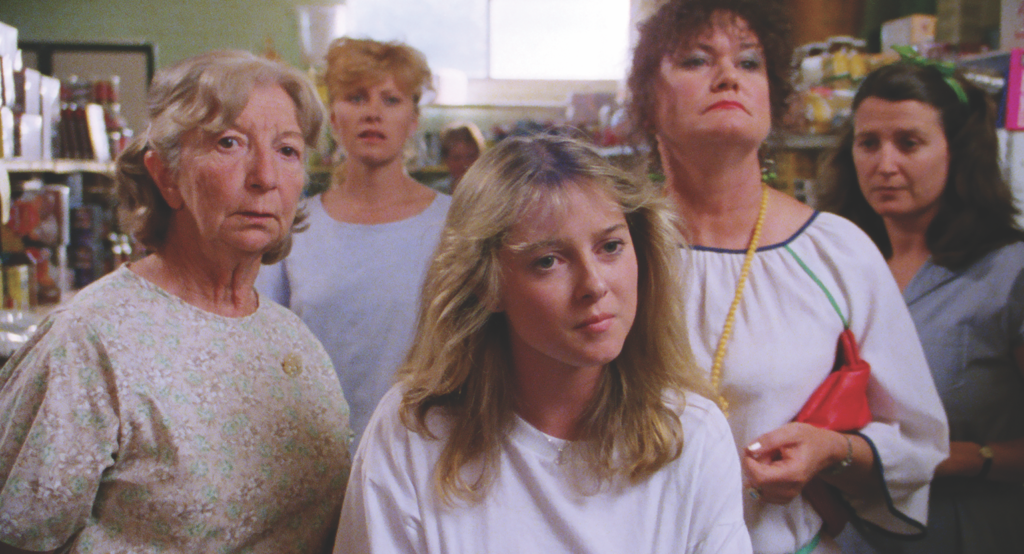
A community of women
Which brings us back to 2019 and the #MeToo movement. In his 1993 book Identification, Gender and Genre in Film: The Case of Shame, Stephen Crofts expounds on how the depiction of rape culture in Jodrell’s film speaks well beyond the parameters of the fictional action that establish its narrative borders:
[R]ape in Ginborak is socially licensed, connived at, perpetuated through a conspiracy of silence, and overall authorized by the oppressively male culture of a small outback town whose social life revolves around its pub.[25]Stephen Crofts, Identification, Gender and Genre in Film: The Case of Shame, Australian Film Institute, South Melbourne, 1993, p. 13.
Replace ‘Ginborak’ with ‘Hollywood’, ‘small outback town’ with ‘large entertainment-industry-focused city’, and ‘pub’ with ‘boardrooms and cinemas’, and no tidier description of the world in which Weinstein and other alleged long-term predators in positions of power were able to thrive for literal decades could be imagined. But Crofts also identifies within the film what, three decades later, would mark the backlash to this institutionalised system of abuse, harassment and violence – what he calls, referring to the events in the film’s conclusion, ‘a collectivity of female action [… that] fights rape’.[26]ibid.
As much as phrases like this might tempt us to retrospectively cast Shame in a universalising light, it is worth underscoring how specifically Australian the film was. While, as Briggs noted above, it certainly received praise overseas, in at least one significant case, its staunch vernacularism and core message about the toxicity of Australian ‘mateship’ fell on deaf ears. In a scathing review for the San Francisco Chronicle, Mick LaSalle describes the film as ‘another one that tries to score points with its audience by getting on the right side of an issue – in this case, rape’:
Shame is against rape. So are we. Shame has contempt for rapists. Us too. Does that mean we’re supposed to like the movie? There’s no point in praising a film for just telling us what we already know, however proper the sentiment.[27]Mick LaSalle, ‘Uninvolving Movie on a Powerful Subject’, San Francisco Chronicle, 16 September 1988.
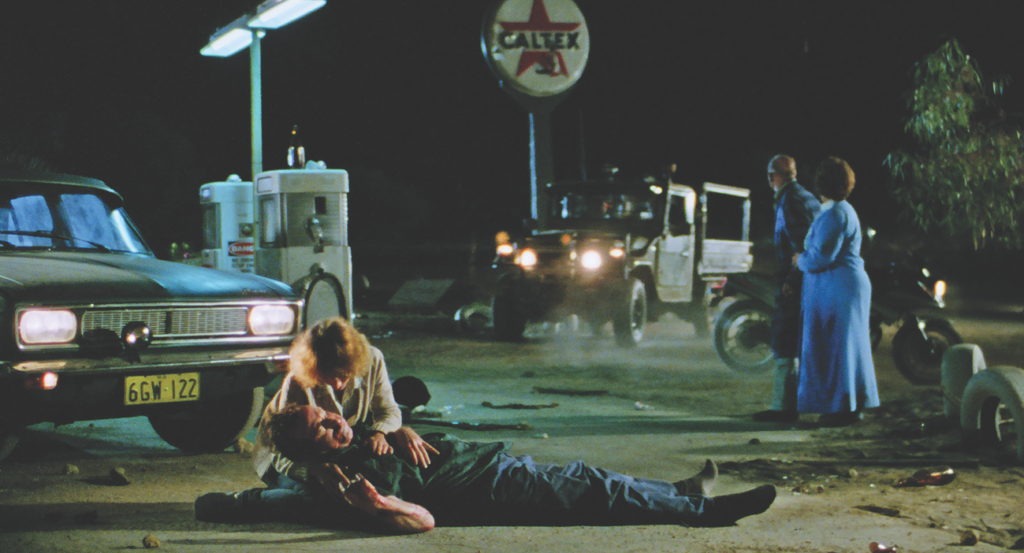
While, at the time, such a position – which, arguably, verges on ridicule – about a film centred on sexual violence and trauma may have been tenable, in the late 2010s, we have seen the men’s rights activist (MRA) movement only continue to rise, with associated figures such as Daryush Valizadeh (aka Roosh V)[28]See Damien Gayle, ‘Nearly 50,000 Sign Petition to Ban Pro-rape Pick-up Artist’, The Guardian, 3 February 2016, <https://www.theguardian.com/uk-news/2016/feb/02/50000-sign-petition-to-ban-events-by-pick-up-artist-and-legal-advocate>, accessed 16 November 2018. and Nathan Larson[29]See Eli Rosenberg, ‘He’s Pro-incest, Pedophilia, and Rape. He’s Also Running for Congress from His Parents’ House.’, The Washington Post, 2 June 2018, <https://www.washingtonpost.com/news/local/wp/2018/06/01/hes-pro-incest-pedophilia-and-rape-hes-also-running-for-congress-from-his-parents-house/>, accessed 16 November 2018. holding pro-rape positions.
The rise of the MRA movement and the prominence of these disturbing views in public discourse today make LaSalle’s eye-rolling dismissal of Shame something of a marker of its zeitgeist – today, as outrageous as this may be, we can no longer assume that everyone is ‘against rape’, as he phrases it. But, as far back as 1992, other Americans saw something in Shame that LaSalle clearly didn’t: four years after Jodrell’s film was released in Australia, an American made-for-television movie remake appeared. Directed by stalwart TV director Dan Lerner (whose credits include programs ranging from Thirtysomething to Grey’s Anatomy), the remake moved the action from rural Australia to the Pacific Northwest, and starred Amanda Donohoe as the Asta character (here called Diana Cadell), Fairuza Balk as Lizzie and Dean Stockwell as her father.[30]Lerner also directed the 1995 sequel Shame II: The Secret, which shifts Diana’s attention from rape to the plight of a man on death row.
Lerner’s Shame is largely loyal to much of the original film’s plot development, character names and even, at times, dialogue – although it also diverges in significant ways. To begin with, the threatened rape of Lizzie’s grandmother is completely deleted. As I have argued elsewhere, there is a strong tendency across all types of cinema for rape to be framed as a threat specific to young, attractive women, amplifying suggestions that sexual violence can be introduced exploitatively in film as a source of transgressive pizzazz rather than arising from any concrete desire to address the subject itself.[31]In terms of the rape-revenge categorisation, at least, Shame stands uniquely next to the extraordinary Turkish film Büyük Kin (Tunç Basaran, 1967) as one of few cases in which depicted victims – or, in the case of Jodrell’s film, a potential victim – are older women, rejecting the otherwise-ubiquitous tendency for these crimes to be inflicted on beautiful young female characters, as discussed earlier. See Heller-Nicholas, op. cit., p. 149. Even more notably, however, is how the American remake reimagines the ending: it is all but completely bereft of the final act of resistance on the part of the community’s women. Instead, Balk’s Lizzie is a martyr – dying for the sake of her fellow women and their future safety, with serious attention now focused on their plight in the face of her death – while Donohoe’s Diana is far closer to the conventional ‘hero’ of the captivity narrative. It is she, not one of the townswomen, who mobilises action, telling another rape victim: ‘Things are going to change; this is where it starts.’ The Australian film may end somewhat ambivalently, particularly in terms of showing Asta shaken by the events and visibly doubting her own actions and influences on Lizzie’s fate, but the American version is much tidier and more simplistic: a final title screen lists rape statistics, ultimately suggesting that ‘“helpless” maidens’ can, in fact, be rescued by ‘heroes’. In direct opposition to what is espoused in Jodrell’s film, this idea supports rather than subverts the tradition of the captivity narrative.
The film’s endurance and unambiguous relevance in today’s #MeToo era is linked directly to the fact that the women of Ginborak themselves ultimately demand change, rejecting the male-dominated status quo that has led to the death of a young woman in their community.
The power of Jodrell’s Shame lies precisely in how it rejects this tradition: no-one will save you, not even a motorcycle-riding big-city feminist lawyer. While what happens to Lizzie is inescapably bleak, the film’s conclusion is far from victorious for Asta personally. But the film’s endurance and unambiguous relevance in today’s #MeToo era is linked directly to the fact that the women of Ginborak themselves ultimately demand change, rejecting the male-dominated status quo that has led to the death of a young woman in their community. What happens within the narrative confines of Shame therefore resonates with profound urgency across the three decades since it was first released. With questions about women, equality and opportunity in the screen industries demanding answers both internationally and in Australia, Furness’ observation at the time of the film’s release that she took the role because it offered her a unique opportunity as a woman actor could have easily been quoted from the last few months: ‘So many scripts are male dominated,’ she told Perth’s Daily News. ‘The strong character I play is usually played by a man.’[32]Deborra-lee Furness, quoted in Caccetta, op. cit., p. 55.
Perhaps even more striking was what Jodrell described as his own lesson about gender politics and the ubiquity of the threat of sexual violence in the lives of so many women, both locally and around the world. Long before the film was released, he stated, in an interview, words that are equal in their simplicity and impact: ‘Now I am ashamed to be a male, to be aware that women live with the fear of rape all their lives. It’s not just a matter of being careful.’[33]Jodrell, quoted in Waters, op. cit., p. 56. This is the legacy of Shame. This is why it still matters, now more than ever.
This article has been refereed.
Select bibliography
‘A Woman on a Motorbike: Michael Brindley Talks About Shame’, Filmnews, July 1988, p. 10.
Stephen Crofts, Identification, Gender and Genre in Film: The Case of Shame, Australian Film Institute, South Melbourne, 1993.
Alexandra Heller-Nicholas, Rape-Revenge Films: A Critical Study, McFarland, Jefferson, NC, 2011.
Travis Johnson, ‘Steve Jodrell: No Shame’, FilmInk, 26 June 2018, <https://www.filmink.com.au/steve-jodrell-no-shame/>, accessed 16 November 2018.
Rose Lucas, ‘Shame’, in Scott Murray (ed.), Australian Film: 1978–1992, Oxford University Press, Melbourne, 1993, p. 257.
David Stratton, The Avocado Plantation: Boom and Bust in the Australian Film Industry, Pan Macmillan, Sydney, 1990, pp. 218–20.
MAIN CAST
Asta Cadell Deborra-Lee Furness
Lizzie Curtis Simone Buchanan
Tim Curtis Tony Barry
Norma Curtis Margaret Ford
Danny Fiske David Franklin
Sgt Wal Cuddy Peter Aanensen
Mrs Rudolph Pat Skevington
Tina Farrel Gillian Jones
PRINCIPAL CREDITS
Year of release 1988
Length 94 minutes
Director Steve Jodrell
Producers Damien Parer & Paul D Barron
Cinematographer Joseph Pickering
Editor Kerry Regan
Production Manager Peter Copland
Art Director Heinz Boeck
Original screenplay Beverley Blankenship & Michael Brindley
Endnotes
| 1 | See Nadia Khomami, ‘#MeToo: How a Hashtag Became a Rallying Cry Against Sexual Harassment’, The Guardian, 21 October 2017, <https://www.theguardian.com/world/2017/oct/20/women-worldwide-use-hashtag-metoo-against-sexual-harassment>, accessed 16 November 2018. |
|---|---|
| 2 | ‘Robert Hughes Sentenced for Child Sex Offences’, SBS News, 16 May 2014, <https://www.sbs.com.au/news/robert-hughes-sentenced-for-child-sex-offences>, accessed 1 November 2018. |
| 3 | ‘Hey Dad! Star Claims “I Was Abused on Set”’, News.com.au, 18 March 2010, <https://www.news.com.au/entertainment/tv/hey-dad-star-sarah-monahan-claims-i-was-abused-on-set/news-story/244408691e6e7f4f8fa3dafc7601db86>, accessed 16 November 2018. |
| 4 | Simone Buchanan, quoted in ‘Hey Dad! Co-star “Threatened” over Sex Abuse Claims’, The Age, 26 March 2010, <https://www.theage.com.au/national/hey-dad-costar-threatened-over-sex-abuse-claims-20100326-r0bw.html>, accessed 16 November 2018. |
| 5 | See Jodi Kantor & Megan Twohey, ‘Harvey Weinstein Paid Off Sexual Harassment Accusers for Decades’, The New York Times, 5 October 2017, <https://www.nytimes.com/2017/10/05/us/harvey-weinstein-harassment-allegations.html>; and Ronan Farrow, ‘From Aggressive Overtures to Sexual Assault: Harvey Weinstein’s Accusers Tell Their Stories’, The New Yorker, 23 October 2017, <https://www.newyorker.com/news/news-desk/from-aggressive-overtures-to-sexual-assault-harvey-weinsteins-accusers-tell-their-stories>, both accessed 15 November 2018. |
| 6 | See Lisa Murray, ‘Tracey Spicer: More to Come from #MeToo’, Australian Financial Review, 16 February 2018, <https://www.afr.com/lifestyle/arts-and-entertainment/tracey-spicer-more-to-come-from-metoo-20180215-h0w4sn>, accessed 16 November 2018. |
| 7 | Steve Jodrell, quoted in Bron Sibree, ‘Steve Jodrell After Shame’, Cinema Papers, issue 70, November 1988, p. 32. |
| 8 | Steve Jodrell, quoted in Julie Waters, ‘A (Male) Director’s Reflections on a Film About Rape’, The West Australian, 5 June 1986, p. 56. |
| 9 | See Wendy Caccetta, ‘Proud About Shame’, Daily News (Perth), 26 February 1988, p. 55. |
| 10 | Dougal Macdonald, ‘First-class Drama with Horror but Not Fantasy’, The Canberra Times, 10 June 1988, p. 38. |
| 11 | Caryn James, ‘A Macho Australian Arrives on Her Cycle’, The New York Times, 19 March 1988, <https://www.nytimes.com/1988/03/19/movies/review-film-a-macho-australian-arrives-on-her-cycle.html>, accessed 16 November 2018. |
| 12 | Sandra Hall, ‘The Feminist Superwoman’, The Bulletin, 10 May 1988, p. 112. |
| 13 | David Stratton, The Avocado Plantation: Boom and Bust in the Australian Film Industry, Pan Macmillan, Sydney, 1990, p. 219. |
| 14 | See Stuart Cunningham, Framing Culture: Criticism and Policy in Australia, Allen & Unwin, Sydney, 1992, p. 149; Rose Lucas, ‘Shame’, in Scott Murray (ed.), Australian Film: 1978–1992, Oxford University Press, Melbourne, 1993, p. 257; and Evan Williams, ‘The Lone Rider Routs the Lotus’, The Weekend Australian, 30 April – 1 May 1988, p. 63. |
| 15 | Steve Jodrell, quoted in Stratton, op. cit., p. 219. |
| 16 | Joe Bob Briggs, ‘Vengeful Woman Cuts Rapists Down to Size’, The San Francisco Examiner, 19 February 1989, p. 25. |
| 17 | Jacinda Read, The New Avengers: Feminism, Femininity and the Rape-Revenge Cycle, Manchester University Press, Manchester, 2000, p. 125. |
| 18 | Alexandra Heller-Nicholas, Rape-Revenge Films: A Critical Study, McFarland, Jefferson, NC, 2011, p. 70. |
| 19 | Elliott Gruner, ‘Rape and Captivity’, Jump Cut: A Review of Contemporary Media, no. 39, June 1994, pp. 51–6, available at <http://www.ejumpcut.org/archive/onlinessays/JC39folder/RapeandCaptivity.html>, accessed 16 November 2018. |
| 20 | Michael Brindley, quoted in ‘A Woman on a Motorbike: Michael Brindley Talks About Shame’, Filmnews, July 1988, p. 10. Shame was co-written by Brindley and Beverley Blankenship, and the former emphasises that their collaboration was essential to the script’s strengths. In this same interview, he notes: ‘I was the one who actually wrote the dialogue, simply because I’m Australian and Beverley’s not […] But the impetus, the passion and the very singleminded grip on what the film was about came from Beverley. She was the conscience of the film […] In a sense her vision was rather black and white, which gives the film a lot of punch, whereas I’m more inclined to see things in shades of grey. I was interested in doing more with the boys, for instance, but Beverley wanted the boys treated the way women usually are in films, taken for granted. I hope that Shame has just enough of the boys to make them plausible, while keeping true to Beverley’s resolve that the women’s responses were to be the central subject.’ |
| 21 | Sarah Projansky, Watching Rape: Film and Television in Postfeminist Culture, New York University Press, New York, 2001, p. 60. |
| 22 | ‘The Fire from Furness Outshines the Shame’, The West Australian, 8 August 1990, p. 59. |
| 23 | Kathi Maio, Popcorn and Sexual Politics, The Crossing Press, Freedom, CA, 1991, p. 124. |
| 24 | Lucas, op. cit., p. 257. |
| 25 | Stephen Crofts, Identification, Gender and Genre in Film: The Case of Shame, Australian Film Institute, South Melbourne, 1993, p. 13. |
| 26 | ibid. |
| 27 | Mick LaSalle, ‘Uninvolving Movie on a Powerful Subject’, San Francisco Chronicle, 16 September 1988. |
| 28 | See Damien Gayle, ‘Nearly 50,000 Sign Petition to Ban Pro-rape Pick-up Artist’, The Guardian, 3 February 2016, <https://www.theguardian.com/uk-news/2016/feb/02/50000-sign-petition-to-ban-events-by-pick-up-artist-and-legal-advocate>, accessed 16 November 2018. |
| 29 | See Eli Rosenberg, ‘He’s Pro-incest, Pedophilia, and Rape. He’s Also Running for Congress from His Parents’ House.’, The Washington Post, 2 June 2018, <https://www.washingtonpost.com/news/local/wp/2018/06/01/hes-pro-incest-pedophilia-and-rape-hes-also-running-for-congress-from-his-parents-house/>, accessed 16 November 2018. |
| 30 | Lerner also directed the 1995 sequel Shame II: The Secret, which shifts Diana’s attention from rape to the plight of a man on death row. |
| 31 | In terms of the rape-revenge categorisation, at least, Shame stands uniquely next to the extraordinary Turkish film Büyük Kin (Tunç Basaran, 1967) as one of few cases in which depicted victims – or, in the case of Jodrell’s film, a potential victim – are older women, rejecting the otherwise-ubiquitous tendency for these crimes to be inflicted on beautiful young female characters, as discussed earlier. See Heller-Nicholas, op. cit., p. 149. |
| 32 | Deborra-lee Furness, quoted in Caccetta, op. cit., p. 55. |
| 33 | Jodrell, quoted in Waters, op. cit., p. 56. |
